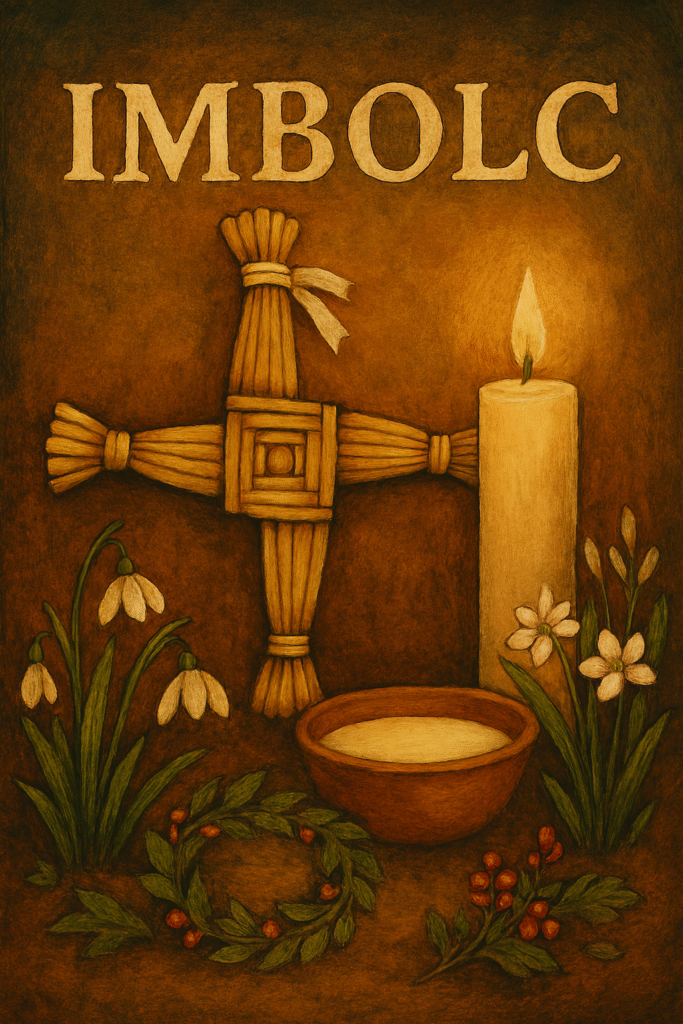
Imbolc, celebrated on or around 1st February, marks the midpoint between the Winter Solstice and the Spring Equinox. Rooted in ancient Celtic tradition, it honours the first signs of spring, the stirring of life beneath the frozen earth, and the goddess Brigid—patron of healing, fertility, poetry, and smithcraft. Imbolc is a time of quiet transformation, when the promise of light begins to manifest and the seeds of intention are sown.
Historical Origins
The name Imbolc is believed to derive from the Old Irish i mbolg, meaning “in the belly,” referencing the pregnancy of ewes and the fertility of the land. It was a pastoral festival, closely tied to the rhythms of livestock and agriculture, and signified the beginning of the lambing season.
In pre-Christian Ireland, Imbolc was dedicated to Brigid, a revered goddess later syncretised into Saint Brigid following Christianisation. Her feast day, 1st February, coincides with Imbolc and retains many of its original customs. Brigid was associated with sacred wells, healing, fire, and poetic inspiration—elements that continue to shape Imbolc observances.
Folklore and Symbolism
Imbolc is rich in folkloric symbolism, reflecting themes of purification, inspiration, and rebirth. Key motifs include:
- Brigid’s Cross: A woven symbol made from rushes or straw, traditionally hung in homes for protection and blessing. It represents the turning of the seasons and the sacred feminine.
- Sacred Flame: Brigid’s eternal flame, kept by priestesses in Kildare, symbolises illumination, creativity, and spiritual awakening. Candles and hearth fires are lit to honour her presence.
- Snowdrops and Early Blooms: The first flowers of the season—such as snowdrops and crocuses—are seen as signs of Brigid’s touch and the earth’s reawakening.
- Holy Wells: Pilgrimages to sacred springs and wells were common, with offerings made to invoke healing and fertility.
Rituals and Traditions
Imbolc rituals are gentle and introspective, focusing on purification, intention-setting, and honouring the returning light. Common practices include:
- Candle Lighting: Homes and altars are illuminated with candles to symbolise Brigid’s flame and the growing power of the sun.
- House Blessings: Cleansing the home with smoke (from herbs like rosemary or mugwort) and sprinkling spring water invokes renewal and protection.
- Poetry and Craft: Creative expression is encouraged, especially writing, weaving, and crafting Brigid’s crosses or seasonal decorations.
- Nature Offerings: Seeds, milk, and bread are offered to the land or placed on altars to honour fertility and abundance.
- Divination and Meditation: Imbolc is an ideal time for reflection, journaling, and seeking guidance for the year ahead.
Gift-Giving and Seasonal Tokens
While Imbolc is not traditionally a gift-exchange festival, modern practitioners often share symbolic items to mark the occasion and honour Brigid’s spirit. Popular gifts include:
- Handmade Brigid’s Crosses: Crafted from rushes or straw, these are given as blessings for protection and inspiration.
- Candles and Incense: Especially those infused with herbs like lavender, rosemary, or frankincense, representing purification and light.
- Herbal Bundles and Oils: Used for cleansing rituals or healing, often featuring seasonal plants and sacred blends.
- Poetry and Art: Personal creations—written, painted, or woven—are shared to celebrate Brigid’s patronage of creativity.
- Crystals and Charms: Stones like moonstone, amethyst, and garnet are gifted for spiritual insight and renewal.
- Seasonal Foods: Breads, dairy products, and honey-based treats are exchanged or offered in ritual, reflecting Imbolc’s pastoral roots.
Conclusion
Imbolc is a quiet yet powerful celebration of transition—when winter’s grip begins to loosen and the first whispers of spring emerge. It invites reflection, creativity, and connection with the sacred cycles of nature. Through firelight, poetry, and symbolic gifts, Imbolc honours the goddess Brigid and the enduring promise of renewal. Whether through ritual or simple seasonal observance, it offers a moment to pause, bless, and begin anew.
